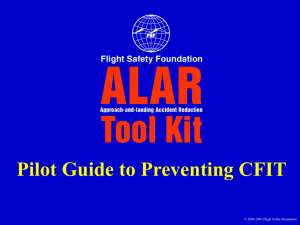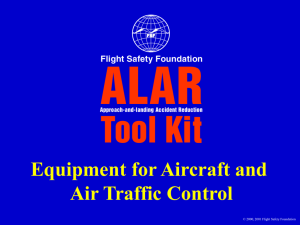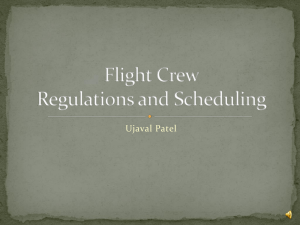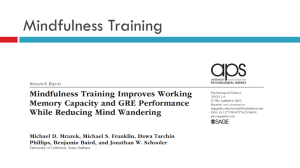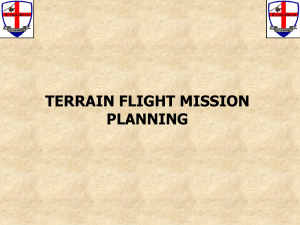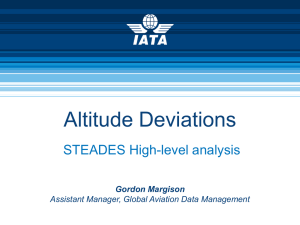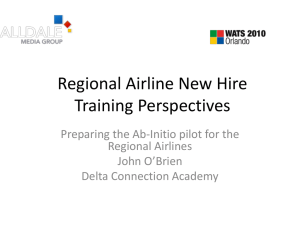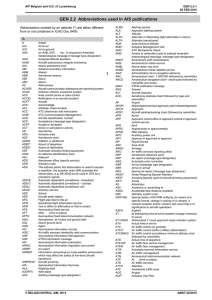Pilot Guide to Preventing CFIT
advertisement
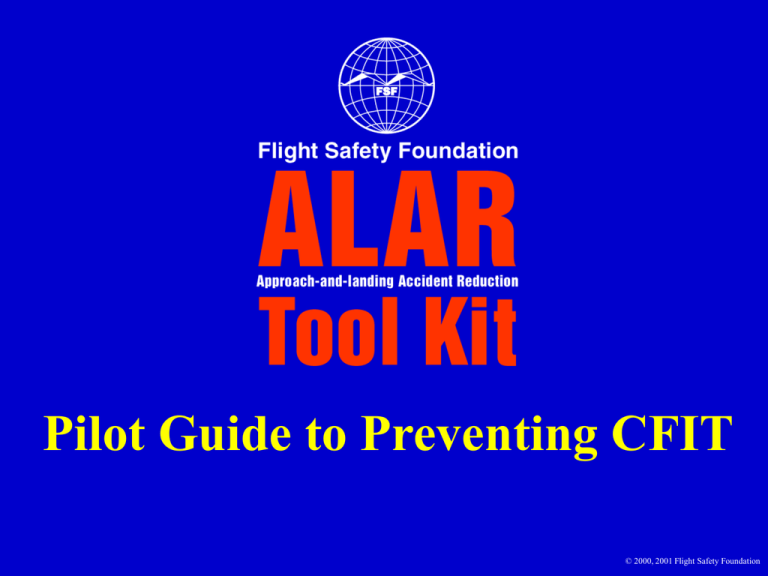
Pilot Guide to Preventing CFIT © 2000, 2001 Flight Safety Foundation CFIT Defined Controlled flight into terrain (CFIT) occurs when an airworthy aircraft under the control of the flight crew is flown unintentionally into terrain, obstacles or water, usually with no prior awareness by the crew. This type of accident can occur during most phases of flight, but CFIT is more common during the approach-and-landing phases, which typically comprise about 16 percent of the average flight duration of a large commercial jet. Fatalities by Accident Categories Fatal Accidents, Worldwide Commercial Jet Fleet (1990-1999) Approach-and-landing Accidents Distance from runway threshold Accidents during a 5-year period 80 70 • 75 accidents/incidents (25 greater than 8 nm) 60 • 2293 total fatalities (approach/landing only) Cumulative number of 50 undershoots Middle marker Two-thirds of the accidents happened within 8 miles of the runway Average outer marker, 5 nm 40 30 20 9 8 7 6 5 4 3 2 Distance to runway threshold (nm) 1 0 CFIT ALAs Map location of CFIT accidents/incidents From runway threshold, 40 accidents/incidents Runway threshold 5 10 15 Tracks where a map display would have probably helped pilot(s) identify and correct problem In most of the CFIT accidents, the airplane was lined up with the runway. Fatal accident track Incident track (continued) CFIT ALAs (continued, #2) Vertical profile of some recent CFIT accidents/incidents 3000 3º There was a lack of vertical situation awareness. Outer marker, 5nm 2000 Altitude (feet) 1000 0 10 9 200 180 8 7 6 5 4 3 2 Distance to runway threshold (nm) 160 140 120 100 80 60 Average time (seconds) 40 1 0 20 0 Factors That Contribute to CFIT Awareness • • • • Altimeters Safe altitude Air traffic control Flight crew alertness • Standard operating procedures • Autoflight system • Training – Terminal instrument procedures – Simulator • Briefings and callouts Altimeters Inches of Mercury • • • • • • • Hectopascals Millibars Know what altimeter units of measurement are used for the area. Be vigilant during radio transmission. Verify if in doubt. Be prepared to convert feet and meters. Know the phase of flight to apply the appropriate altimeter setting. Use altimeter setting cross-check and readback cockpit procedure. Cross-check radio altimeter and barometric altimeter readings. Operate at higher than minimum altitudes during atmospheric anomalies. Altimeter Recommendations • Set/cross-check radio altimeters • Geometric altitude – EGPWS improvement • QFE selectable altimeters and autopilots • Eliminate three-needle altimeters • Standardize phraseology for altimeter settings – Pilots and ATC – Units/digits “Mountain range off to left— check. MSA—check. Minimums— check.” Safe Altitude • Make sure adequate charts are available. • Study the altitude information. • Know and fly at or above the safe altitudes for your area of operation. • Understand terrain clearance limitations for approaches. Safe Altitude Recommendations • Study terminal instrument procedures and definitions. • Ensure that charts are up-to-date and use the color terrain contours when available. • Study GPWS/TAWS procedures. “Proceed direct to airport.” “Roger that…I better check my altitude requirement.” ATC • Challenge or refuse ATC instructions when they are not clearly understood, are questionable or conflict with your assessment of aircraft position relative to the terrain. • Exercise good radio communication discipline. • Know the height of the highest terrain or obstacle in the operating area. • Know your aircraft’s position in relation to the surrounding high terrain. ATC Recommendations • Use standard phraseology. • Do not accept unreasonable clearances. – You are responsible for altitude clearances. • Demand clear understanding of clearances. – Operate autopilot using the mode that facilitates compliance with ATC instructions. • Readback of clearances is essential to assure that everyone agrees with the clearance content. Flight Crew Complacency • Know that familiarity can lead to complacency. • Do not assume that this flight will be like the last flight. • Adherence to procedures helps to eliminate crew complacency. Flight Crew Complacency Recommendations • Strict adherence to standard operating procedures. • Good crew resource management practices. • Emphasis on the operational differences in briefings and in conducting the flight. • Maintain a professional attitude towards flying . Procedures • Do not invent your own procedures. • Follow company standard operating procedures. • Know what approach and runway aids are available before initiating an approach. • Use all available approach and runway aids. • Use every aid to assist you in knowing your position and knowing the required altitudes at that position. Attempting to modify approach procedures using the electronic flight instrument system (EFIS) map display resulted in this accident. Fly the published approach procedure. Do not improvise. Understand Approach Charts • Identify unique gradient and step-down requirements. • Review approach procedures during approach briefing (preferably before top of descent). • Use autoflight systems, when available. Stabilized Approaches “I’m not stabilized. I’m going around!” • Fly stabilized approaches. • Execute a missed approach if not stabilized by 500 feet above airport elevation in VMC or 1,000 feet above airport elevation in IMC. Procedural Recommendations • Follow standard operating procedures. • Understand approach/missed approach and departure procedures, and comply with them. • Use all available aids (autopilot, autothrottles, navaids, etc.) to assist in complying with procedures. • Practice good crew resource management. • Fly stabilized approaches — if not stabilized, GO AROUND. Autoflight System • • • • Monitor the autoflight system for desired operation. Use the best available mode for current flight conditions. Follow procedures. Monitor navigation performance. Autoflight System Recommendations • Appropriately use the autoflight system to reduce crew workload. • Use autoflight capabilities to fly stabilized approaches. • If available and if the crew has been trained, use the autoflight system to fly constant-angle nonprecision approaches. Training Terminal Instrument Procedures (TERPS)/Procedures for Air Navigation Services – Aircraft Operations (PANS OPS) Volume II • Crews should enhance their knowledge of horizontal and vertical terrain clearance. • Crews need to understand why they must adhere to standard operating procedures while flying in IMC. Skilled work is behind instrument approach procedures. All the pilot has to do is accurately fly the procedure. Procedure Turn Areas (TERPS) Protected Areas (TERPS) Protected Areas (PANS OPS) Procedure Turn Initial Approach Area (TERPS) Understand Terrain Clearance for Each Segment and Type of Approach (TERPS) Straight-in nonprecision approach Straight Missed Approach Area (TERPS) 2 nm MAP Primary Area 4 nm Missed Approach Course Final 40:1 15 nm from MAP 4 nm Width of Area Varies at the MAP 2 nm Straight Missed Approach Obstacle Clearance (TERPS) MAP Min Obstn Clnc on Final 15 nm Runway Go-around climb performance could determine MDA altitude and MAP position. Missed Approach Area (PANS OPS) Note: The 2.5% climb gradient PANS OPS requires is exactly the same as the 40:1 climb gradient TERPS requires. Turning Missed Approach Area MAP MAP (TERPS) (180-degree turn) 2 nm 4 4nm nm 4 nm 2 2 nm nm Turning Missed Approach Radii (miles) (TERPS) Approach Category Obstacle Clearance Radius Flight Path Radius 2.6 2.8 3.0 3.5 5.0 1.30 1.40 1.50 1.75 2.50 Max Speed A B C D E (90) (120) (140) (165) (Military) Simulator • Be prepared to demonstrate GPWS/TAWS escape maneuver. • Practice CFIT knowledge during approach, missed approach and departure procedures. • Practice altitude awareness (instructors should promote this). • Demonstrate good crew resource management techniques. Briefings and Callouts • Crews should adhere to company SOPs. • Terrain awareness is a primary reason why we conduct briefings and callouts. • Both pilots should promote a common understanding of what is to be expected. Typical Takeoff Briefing • Weather at the time of departure. • Runway in use, usable length (full length or intersection takeoff). • Flap setting to be used for takeoff. • V speeds for takeoff. • Expected departure routing. • Airplane navigation aids setup. • Minimum sector altitudes and significant terrain or obstacles relative to the departure routing. • Rejected takeoff procedures. • Engine failure after V1 procedures. • Emergency-return plan. Typical Approach Briefing • Expected arrival procedure, including altitude and airspeed restrictions. • Weather at destination and alternate airports. • Anticipated approach procedure, including: – – – – Minimum sector altitudes; Airplane navigation aids setup; Terrain in the terminal area relative to approach routing; Altitude changes required for the procedure; – Minimums for the approach DA(H) or MDA(H); and, – Missed approach procedure and intentions. • Communication radio setup. • Standard callouts to be made by the pilot not flying. CFIT-related Callouts • Upon initial indication of radio altimeter height, appropriate altitude vs. height above terrain should be assessed and confirmed. • When the airplane is approaching from above or below the assigned altitude (adjusted as required to reflect specific airplane performance). • When the airplane is approaching relevant approach procedure altitude restrictions and minimums. • When the airplane is passing the transition altitude/level. Training Recommendations • Be prepared for initial and recurrent flight crew training programs considering CFIT and including terminal instrument procedures. • LOFT (line-oriented flight training) to promote route and destination familiarization programs emphasizing terrain. • Practice proper briefings and callouts to promote terrain awareness. Conclusion If at any time during the approach, you feel that you are out of position or configuration and the safety of flight is compromised, GO AROUND. ALAR Tool Kit • • • • • • • • • • • • • • • • • • • Flight Safety Digest: “ALAR Briefing Notes” Flight Safety Digest: “Killers in Aviation: FSF Task Force Presents Facts About Approach-and-landing and Controlled-flight-into-terrain Accidents” FSF ALAR Task Force Conclusions and Recommendations FSF ALAR Task Force Members Selected FSF Publications Approach-and-landing Risk Awareness Tool Approach-and-landing Risk Reduction Guide Standard Operating Procedures Template ALAR Information Posters CFIT Checklist CFIT Alert Flight Operations and Training Equipment for Aircraft and Air Traffic Control Air Traffic Control Communication Pilot Guide to Preventing CFIT Approach-and-landing Accident Data Overview An Approach and Landing Accident: It Could Happen to You CFIT Awareness and Prevention Links to Aviation Statistics on the Internet More information? Flight Safety Foundation Suite 300, 601 Madison Street Alexandria, VA 22314-1756 U.S. Telephone: +1 (703) 739-6700 Fax: +1 (703) 739-6708 www.flightsafety.org This is a self-contained product of the Flight Safety Foundation Approach-and-landing Accident Reduction (ALAR) Task Force and includes a variety of information to help prevent approach-and-landing accidents, including those involving controlled flight into terrain (CFIT). This information is not intended to supersede operators’/manufacturers’ policies, practices or requirements, or to supersede government regulations. In the interest of aviation safety, the contents of the FSF ALAR Tool Kit may be displayed, printed, photocopied and/or distributed on paper for noncommercial use. Except as specifically permitted above, the contents must not be offered for sale directly or indirectly, used commercially, distributed on the Internet and/or on any other electronic media without the prior written permission of Flight Safety Foundation. All uses of the FSF ALAR Tool Kit must credit Flight Safety Foundation. Contact Roger Rozelle, director of publications, for more information. © 2000, 2001 Flight Safety Foundation (official release v. 3.0) Flight Safety Foundation Suite 300, 601 Madison Street, Alexandria, Virginia 22314-1756 U.S. Telephone: +1 (703) 739-6700; Fax: +1 (703) 739-6708 http://www.flightsafety.org
